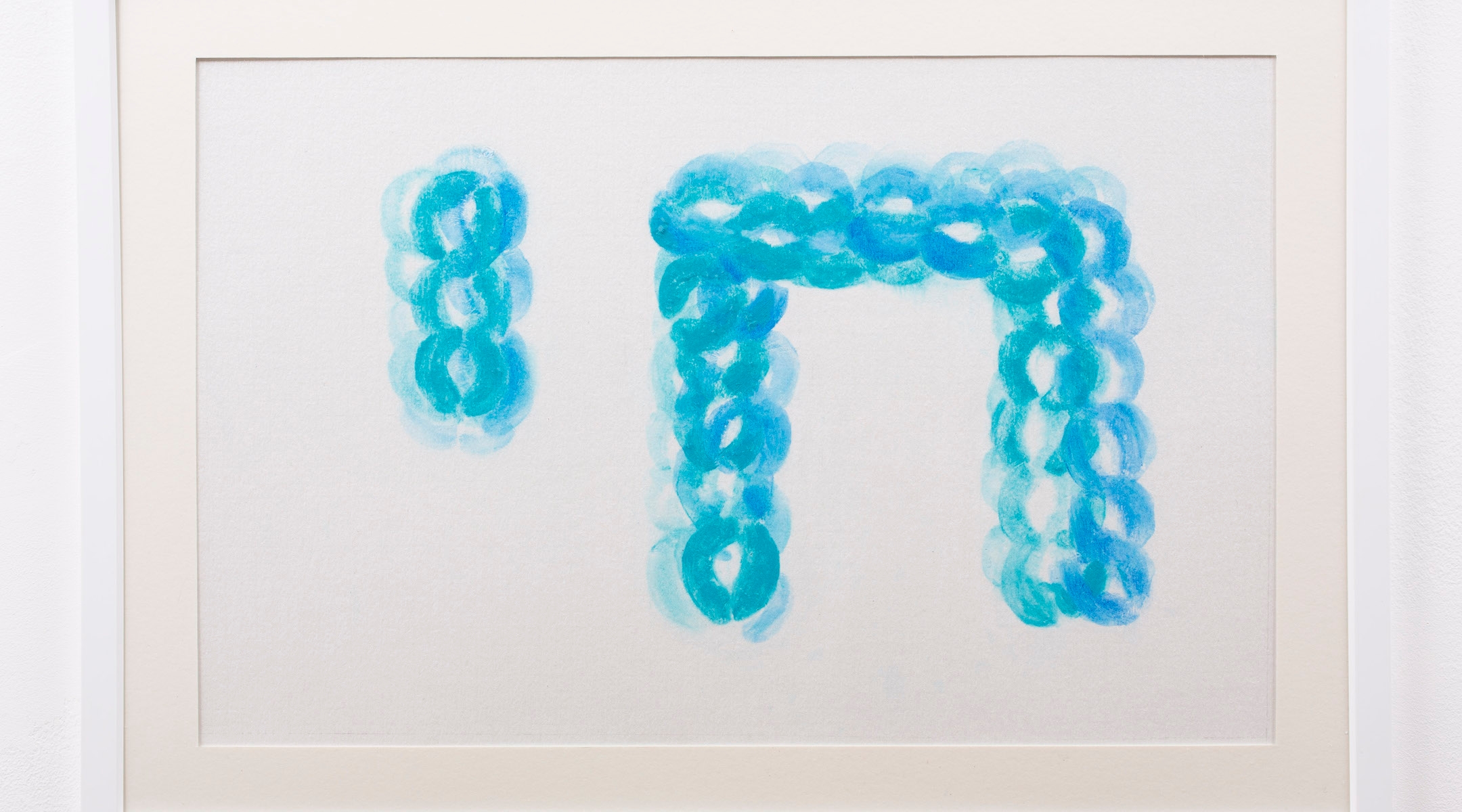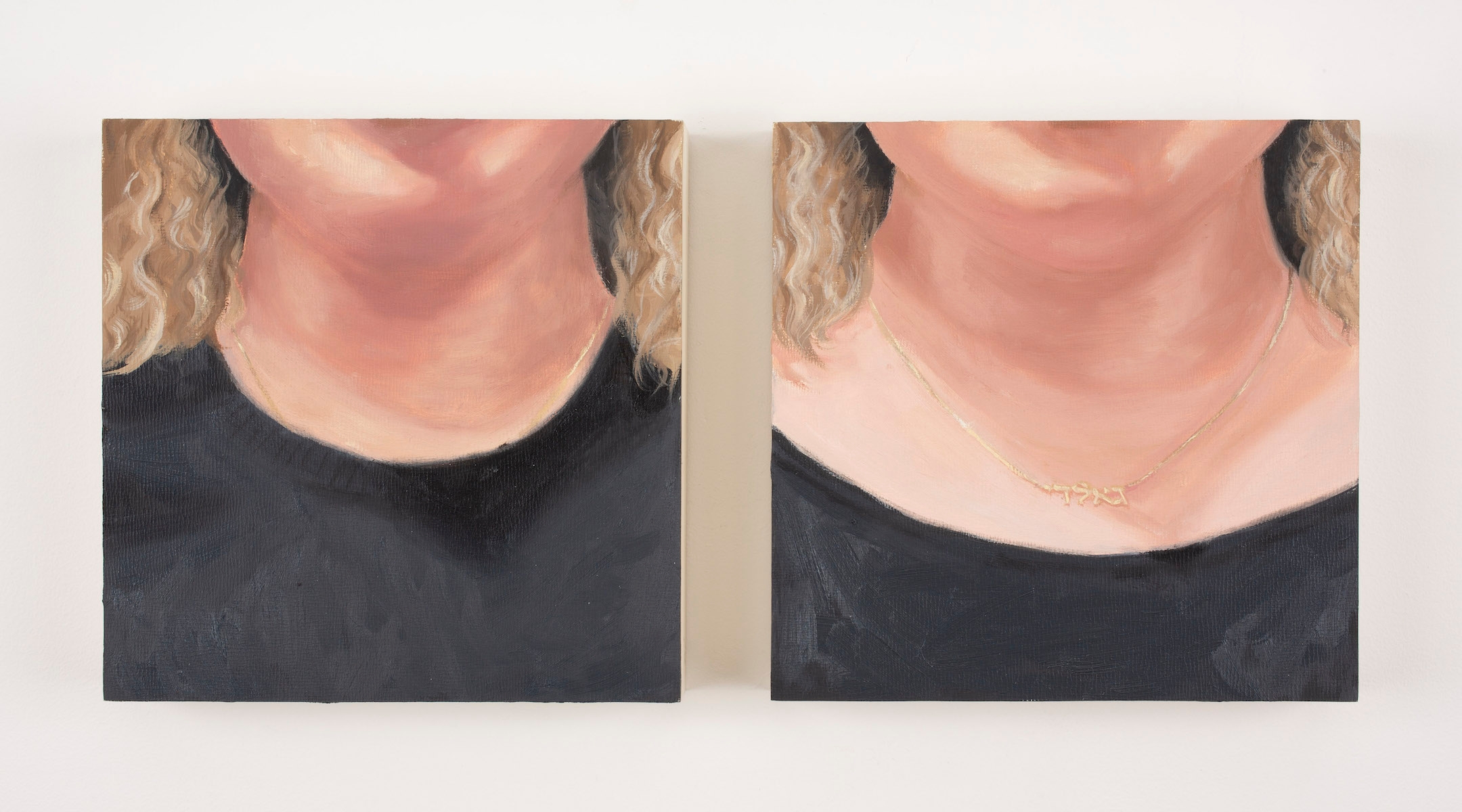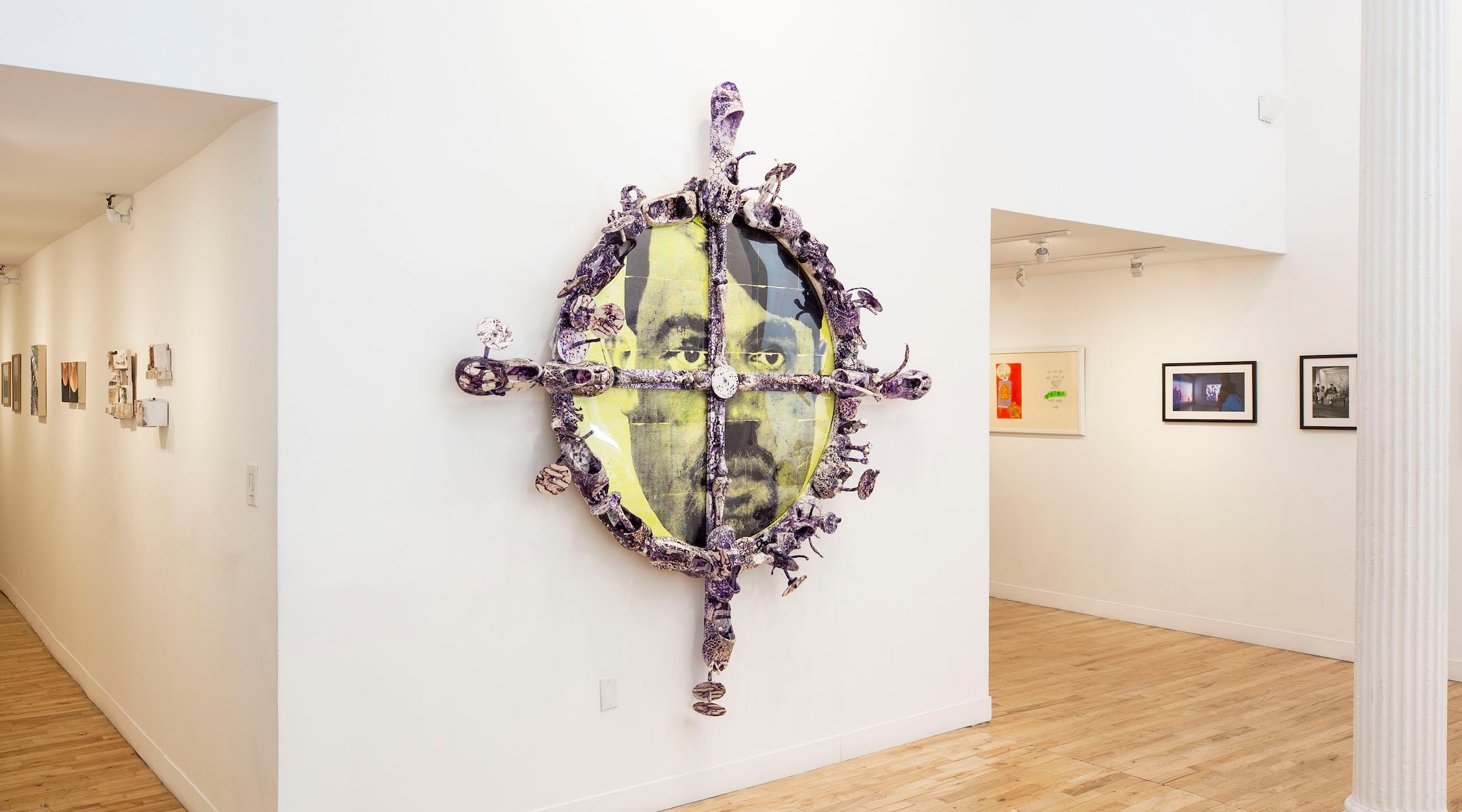Anyone stepping inside 81 Leonard Gallery — an artist-run space named after its Tribeca address — will come face to face with Adolf Hitler.
The Hitler on display at this gallery, one of dozens dotting the tony Manhattan neighborhood, sports the recognizable “toothbrush” mustache and swoop of brown hair that characterize portraits of the Nazi leader.
But this portrait is done in a striking yellow and purple, with some unusual features — including a goatee and square jawline — more often associated with someone who’s become notorious for antisemitism in the present era: rapper Kanye West.
“Yitler,” created by artist Marina Heintze by layering images of both men’s faces, is one of 38 pieces currently on view at 81 Leonard as part of a pioneering group show, “Artists on Antisemitism.” A project of the Jewish Arts Salon, a global network of Jewish artists based in New York City, 21 artists are exhibiting work that both captures and responds to hatred of the Jewish people — an ancient phenomenon that has renewed itself in recent years.
“I was inspired because I had been tracking Kanye West and the antisemitic statements and rants he’s made for many years, and I’ve come to understand his reach culturally and how many people follow him and listen his music and how dangerous that is,” Heintze, 37, said about her piece. “The similarities between Hitler and Kanye West are both cultural and political.”
Yona Verwer, the founder and director of the Jewish Art Salon and one of the curators of the exhibit, first thought to put together the show after the Hamas’ Oct. 7 attack on Israel. In the immediate aftermath, Verwer sent an email to the Jewish Art Salon network, which has many Israeli members, to offer support.
“They wrote back with heart-wrenching stories of what’s going on with their lives — and some of them sent art that they already had made that quickly,” she said.
Around the same time, another of the show’s curators, Judith Joseph, suggested an online exhibit of art made in the aftershock of Oct. 7. Verwer thought the idea could be even more expansive.
“As time went on, the situation started to change and things got crazy [in New York], too,” she said, citing the uptick in antisemitic incidents in New York and around the world. “I realized we need to do something about antisemitism in general. I wanted a real, brick-and-mortar exhibition.”
The two women then connected with Ronit Levin Delgado, an Israeli artist and a member of the Jewish Art Salon who was heavily involved with the hanging of “Kidnapped” posters around the city in the weeks following Oct. 7. Levin Delgado had just received a grant as part of a partnership between New York City’s Office for the Prevention of Hate Crimes and COJECO, a nonprofit that works with the Russian-speaking Jewish community, to create art about antisemitism. The three teamed up with the curators at 81 Leonard Gallery, Nancy Pantirer and Hannah Rothbard, to work on an exhibit together.

“Alive” made out of blue lipstick by Ronit Levin Delgado. (Roman Dean)
In early April, Verwer opened a call for submissions for artwork that grappled with antisemitism to her 500-member network in the Jewish Art Salon. The response, said Verwer, was “overwhelming.” Of the 50 who applied to feature in the exhibition, the curators whittled it down to 21 artists who range in age from 25 to 81 and come from eight states as well as from Israel.
“What you see is a small selection of what came in — there were so many people dying to participate in this,” Verwer said. “It’s a Jewish group and we’re here to support each other and create community — that’s what people want.”
Since Oct. 7, “Everybody feels a crunch being afraid to be a Jewish artist,” she said. “Artists who never really formally said, ‘I’m Jewish’ are all of a sudden seeing how important it is to them.”
The 38 pieces on view — which include painting, photography, sculpture and mixed media — fill the space at 81 Leonard, which is home to a traditional gallery in front and a large, airy work space in the back. Some work focuses on antisemitism of the past — with art and photographs centering on the Holocaust — while others center on the present, creating art to capture what antisemitism means for Jews at this particularly fraught moment in time.

“Neck Piece” by Goldie Gross. (Roman Dean)
For example, one painting, by Isaac Ben Aharon, is a portrait of Deborah Lipstadt, the United States’ special envoy to monitor and combat antisemitism. Another is a diptych of a woman wearing a necklace with her Hebrew name on it — one version of the necklace tucked into her shirt and one version of her displaying it proudly.
“This diptych — which can be read from covered to uncovered or vice versa — is about the choices we make in identifying ourselves as visibly Jewish and the factors and anxieties that play into it,” the artist, Goldie Gross, writes in the didactic label next to the piece.
Still more, like Heintze’s “Yitler,” draw comparisons between Hitler’s antisemitism — which most Americans never experienced themselves — and the antisemitism many have encountered firsthand. Meanwhile, one three-dimensional piece, “Emergency Golem” created by Maxwell Bauman, is a riff on the protector of the Jewish people first found in 16th-century legend: It’s a golem made out of Legos and stored inside a “break-in-case-of-emergency” plastic box.

Left: “Emergency Golem” by Maxwell Bauman Right: “Our Voice – Ambassador Lipstadt” by Isaac Ben Aharon. (Roman Dean)
“Some of the works that we chose are contemporary, while others give you a more contextual background and history so that you understand that antisemitism has always been there,” Levin Delgado said. “Instead of a history textbook, art can be another way to educate.”
Rothbard, a curator at 81 Leonard who is Jewish, said the gallery decided not put up any signs outside advertising an exhibit on antisemitism — both for security reasons, and to encourage unlikely visitors to stop in and learn more.
“We want anyone and everyone to stop in to see the exhibit and experience it like they would any other art gallery,” Rothbard said.
Working in an exhibit solely dedicated to antisemitism was a first for artists Heintze and Levin Delgado and gallery owner Nancy Pantirer, who is also Jewish. Verwer, who founded the Jewish Art Salon in 2008, previously put together an exhibit about antisemitism in partnership with the Anne Frank Center USA in 2014.
“We’d been struggling with how to work with being Jewish and representing Jewish artists — debating if we were going to talk about the war, which is so complicated, and really, we’re not qualified to,” Pantirer recalled. “But because antisemitism is on the rise — before Oct. 7, too — and no one can walk in here and negate that, we figured, ‘This is it, this is our topic.’”
For the artists, participating in the show has helped create a community around a subject that can feel isolating and emotional. “It’s horrible to face antisemitism, but it was really great to participate in this exhibit because there’s a mutual understanding and I felt like people just ‘got it’ and it’s very welcoming,” said Heintze, who also has two other works in the exhibit.
“I’m Israeli — I’m not used to experiencing antisemitism,” Levin Delgado said. “When I came to America, I realized I’ve taken that for granted. There have always been Jewish themes in my work, but as an Israeli, to work on something like this has been extra meaningful to me.”
In addition to curating the show, Levin Delgado contributed a piece. Called “Alive, ” the artwork is of Hebrew word “chai” made out of kisses of blue lipstick that’s meant to “embody the eternal vitality of the Jewish people,” Levin Delgado wrote in her description of the work.
“The most beautiful thing about our nation is that we are there for each other,” she said of the Jewish community at large. “This is the strongest, most empathetic community. It doesn’t matter if you’re Sephardic or Ashkenazi or Mizrahi — right now we are all Jewish and we are all there for each other.”
“Artists on Antisemitism” is on view Thursday-Sunday from 12-6 p.m. at 81 Leonard Gallery through Aug. 30.
The New York Jewish Week brings you the stories behind the headlines, keeping you connected to Jewish life in New York. Help sustain the reporting you trust by donating today.





